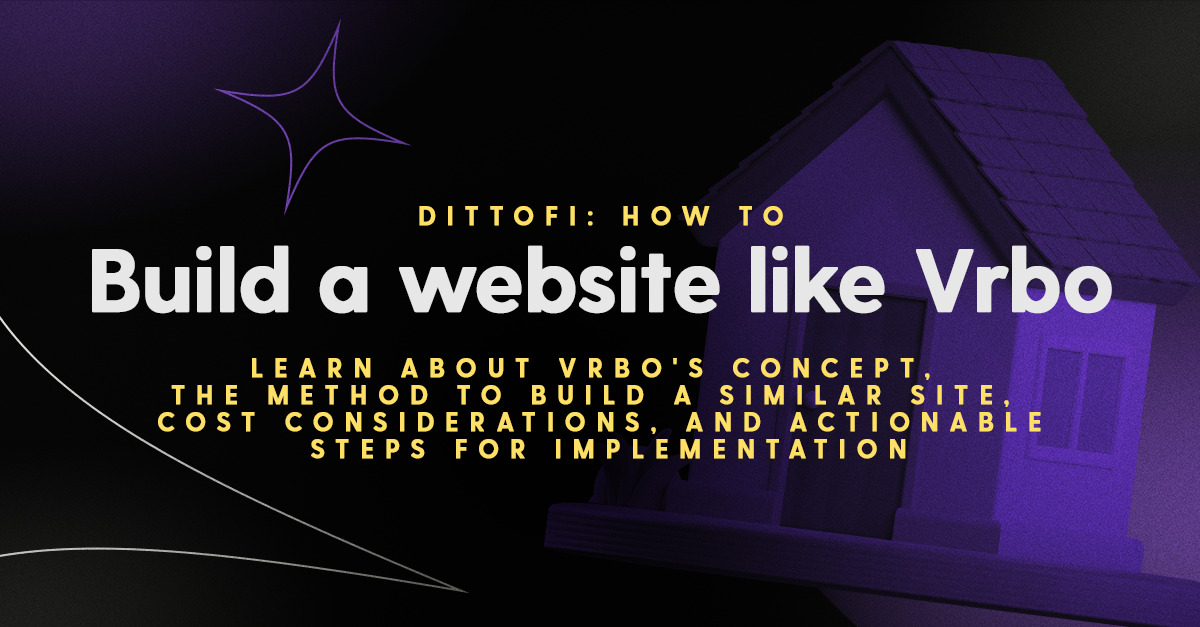Building a vacation rental website like Vrbo can be highly lucrative. Vrbo reported revenue of $2.7 billion in 2022. Not bad for a short-term rental vacation platform that competes with Airbnb.
But Vrbo is not the only successful vacation rental marketplace website. Niche platforms like GlampingHub, BringFido, Kid & Coe, and many others are each carving out their own sections of the market. Each offers unique features tailored to specific traveler needs, proving there’s still plenty of room for innovation in the online vacation rental space.
In this comprehensive guide, we’ll show you how to build a vacation rental website like Vrbo, Airbnb, GlampingHub, BringFido, and more. We will cover:
What exactly is Vrbo?
Vrbo (Vacation Rentals by Owner) is an online marketplace connecting property owners (hosts) with travelers looking for short-term vacation rentals. It is a location-based, peer-to-peer marketplace focused on offering high-end, family-friendly, and group-oriented accommodations such as vacation homes, cabins, cottages, and condos.
Key Features of Vrbo’s Business Model:
- Location based transactions:
Users must be in the same area as the rental listing to complete a booking.
- Peer-to-peer (p2p) marketplace:
Primarily refers to the type of transactions that take place on the marketplace. On a p2p marketplace, the main user types are private individuals on the host side (supply-side) and private individuals on the guest side (demand-side). These are also known as C2C or customer to customer transactions. - Rental marketplace model:
While Vrbo focuses on vacation property rentals, similar marketplaces can focus on other rental categories.
Now that we know what Vrbo is, let’s take a look what is Vrbo’s niche in the short term vacation rental marketplace.
The Vrbo method: How to build a website like Vrbo
Building a successful vacation rental marketplace like Vrbo requires careful planning and execution.
Since Vrbo was founded in 1995, its focus has been on helping family and friends take vacations together in high end vacation rentals. This focus has massively influenced how Vrbo has designed and built their host and guest experience. For instance, Vrbo has implemented a unique pricing model, cancellation policies, customer service, search and onboarding and review processes.
In this section, we will take a look at the steps you can take to build a website like Vrbo. These include:
Step 1. Find a Niche Vacation Rental Marketplace Idea
The first step to build a vacation rental website like Vrbo is to find a unique vacation rental marketplace niche. Think about how Vrbo targets high-end family and group travelers who prefer spacious and private accommodations.
This means that you need to find a specific segment of the market that caters to a distinct group of customers with particular needs, preferences, or interests that are currently unmet by existing solutions.
To understand this, first think about Vrbo vs Airbnb.
Airbnb focus is on the mass market for short term vacation rentals whereas, Vrbo focuses on delivering a high end vacation rental experience to families and groups looking for more spacious and private lodgings. These include vacation homes, cabins, cottages and condos that can accommodate larger groups or families.
You can see two clear examples of how Vrbo presents itself compared to Airbnb in their 2024 ads Relax/Rooster and Relax/Spaceship.
By focusing on a niche for high end, group travel, Vrbo was able to make more than $2.7 billion in revenue in 2022.
Other niche vacation rental marketplaces include:
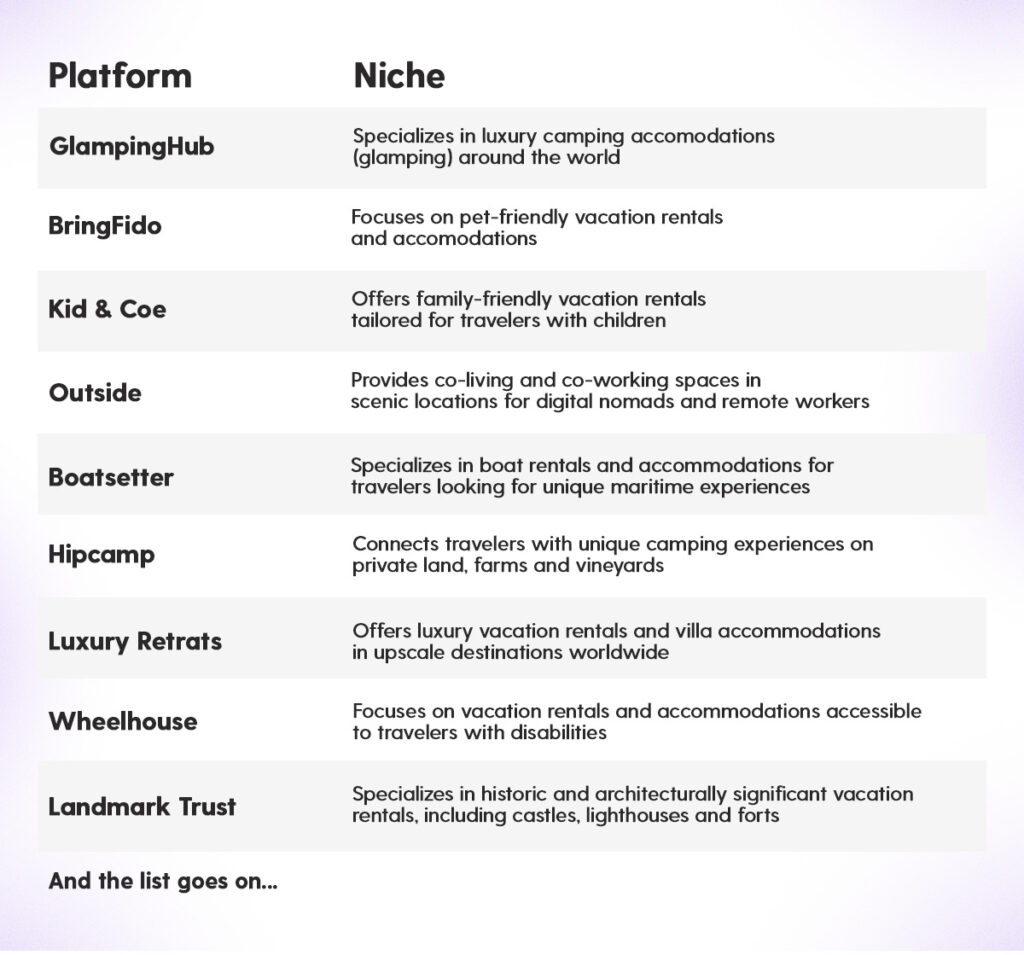
There are plenty of general and niche vacation rental marketplace ideas that remain undone. To find a niche rental marketplace idea like Vrbo, we recommend that you first identify an unmet need for hosts and guests.
For instance, Vrbo found that families and groups of travelers needed more spacious accommodation for their vacation rentals whilst, hosts wanted to rent their property to mature guests who would be respectful of their properties. Therefore, Vrbo realized that they could position their platform so as to take advantage of this gap in the market for vacation rentals.
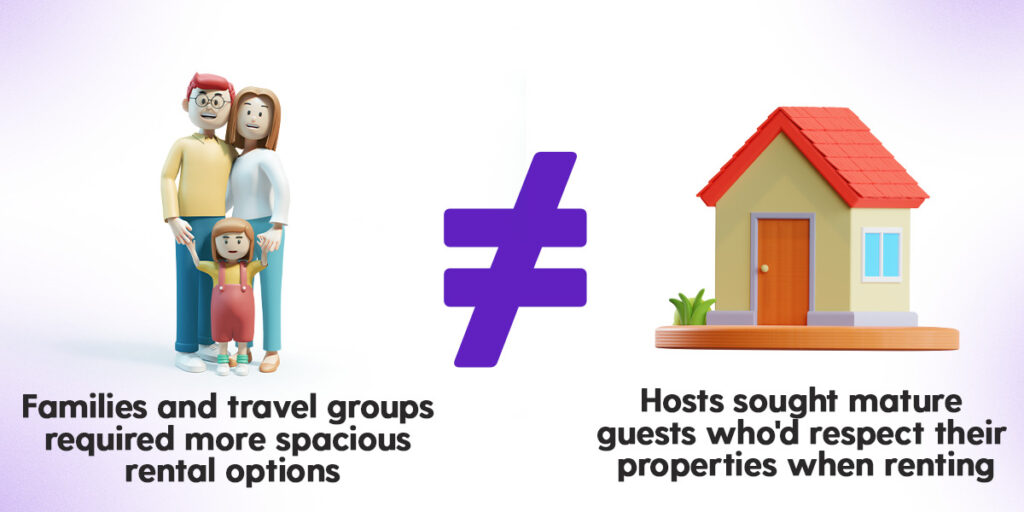
To help find an unmet need, you may wish to analyze the competitive options for short term rentals and look for areas that might not cater to specific types of demographics, preferences or types of travelers. For instance:
- Specialized accommodation: Explore opportunities to offer unique accommodation options tailored to specific demographics or interests such as, eco-friendly lodgings, historic homes, wellness retreats, pet-friendly rentals, accommodations for travelers with artistic interests and so on. By providing specialized accommodation, you can focus on attracting travelers who are seeking specific types of experience.
- Experimental stays: Consider offering experimental or unconventional stays that provide travelers with memorable and unique experiences. For example, you could include themed accommodations (such as treehouses, yurts, or cabins), off-grid retreats, or accommodations in unusual locations (such as lighthouses, caves, or converted vehicles). Experimental stays, can cater to adventurous travelers looking for one-of-a-kind experiences that go beyond traditional accommodations.
- Geographic gaps: Explore regions of the world that are underrepresented on mainstream vacation rental platforms like Vrbo. This could include rural areas, small towns or remote locations.
If you have an existing property portfolio, you may also consider building your own vacation rental website to avoid high transaction fees on the other websites.
Read how to come up with a great idea for your marketplace more information about how to complete this step.
Step 2. Validate your idea for a vacation rental website like Vrbo
Now that you have an idea for a niche vacation rental website like Vrbo, the next step is to validate that there is market demand for your idea.
To validate your idea, there are four steps that you should take.
Define your target audience
Customer discovery is the process of articulating who will be the ideal host and who will be the ideal guest for your vacation rental marketplace. To do this, you can write a positioning statement that explains the platforms value proposition.
In the case of Vrbo their positioning statement is:
“Vrbo is a global vacation rental marketplace that connects travelers with property owners and managers, offering a wide range of accommodations to suit diverse travel needs.”
Out of Vrbo’s positioning statement we get their value proposition which is:
“Vrbo’s ability to offer traverllers a wide range of spacious, family-friendly and private vacation rental accommodations, connecting them directly with property owners and managers.”
It may not be immediately obvious but both the positioning statement and the value proposition make various assumptions about Vrbo’s target customers and their need for a new vacation rental marketplace. For instance, Vrbo is assuming that prioritize spacious and private accommodations, value direct communication with property owners or managers, and seek a family-friendly vacation rental experiences that they cannot find elsewhere.
Before moving on, you should try writing out the positioning statement for your vacation rental marketplace and a value proposition. You can then try listing out some of the assumptions that you’re making about the need your target customer has for your marketplace.
Test assumptions about your target customer
Now that you have a clear idea about your target market, the next step is to test any assumptions that you’re making about your target market. To do this, you need to design and run experiments.
The simplest way to do this is to take your list of assumptions and choose the riskiest assumption. For example, in the case of Vrbo, the riskest assumption may have been that their target customers are seeking family-friendly vacation rental experiences.
Once you have the assumption, design a quick experiment to test if this assumption is accurate. For example, you can design a product landing page that speaks directly that offers features that speak directly to your target audience, and see if you can get people to sign up for that platform.
If you cannot get anyone to sign up, this means that there is likely NOT a burning need for your product. Therefore, you need to go back to the drawing board and rethink your target market.
At Dittofi we’ve created a tool called the Idea Validation Board. This dashboard has been designed to help you structure your thought process when designing and running experiments.
Assess market size and share
Once you’ve determined that there is a need for your marketplace, the next step is to validate that your target market is large enough that it is worth going after.
In Vrbo’s case, their were a couple of metrics they can use to determine if the market size is larger enough or not. These include:
- Total Addressable Market (TAM). This refers to the total revenue opportunity available for a product or service within a specific market. For Vrbo, the global vacation rental market was estimated at US$ 92 billion in 2021 and is expected to reach over US$ 317.76 billion by 2030.
- Size of the niche market. This refers to the total revenue opportunity for the section of the Total Addressable Market (TAM) that you are specifically targeting. For Vrbo, this could be defined as families and group travellers in their 30s, looking for vacation rentals in certain target geographies.
- Growth rate of niche market. This is the rate at which the niche market is growing. For instance, Vrbo would notice that millennials are the primary driver of the growth in short term vacation rentals meaning that their niche market is getting bigger.
Research search volume of related keywords
Another way to get a realistic view of the market size and the competitive landscape is to research monthly search volume on keywords related to your target audience. This can help to reveal interesting insights as consumers looking for.
There are various tools that you can use for this such as Ahref, Moz, Semrush and so on. Using these tools, you can find keywords that travelers are searching for when planning their vacation. By doing this research, you can find high volume keywords that have low competition (or keyword difficulty). You can then build a targeted landing page that shows up for these keywords.
For example, in Vrbo’s case, they might be interested to know that more than 1000 people each month are searching for family vacation rentals. You can see this result in the graphic below if you look at the search volume associated with each of the keyword suggestions.
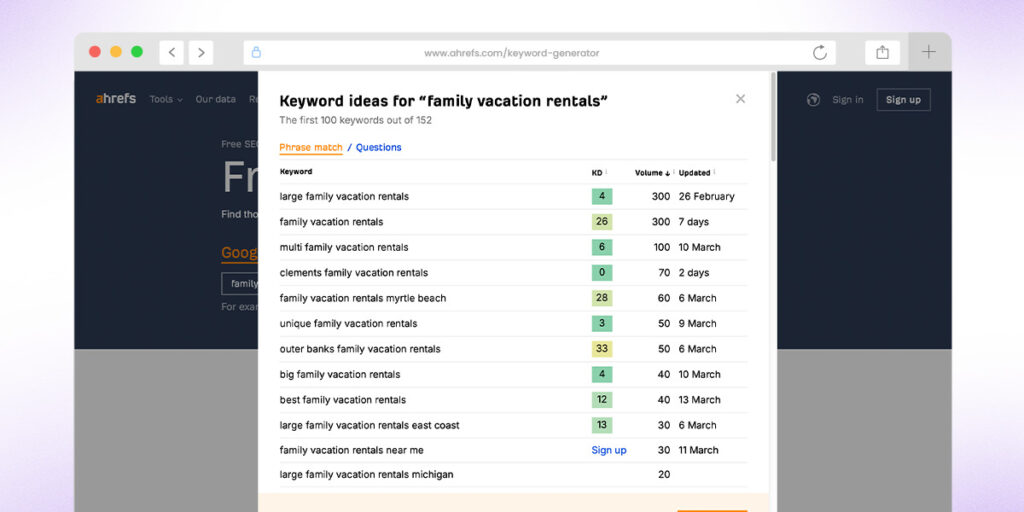
Indeed, if I search for family vacation rentals in Google, we find Vrbo in the top search engine results. Alongside Kid & Coe and Family Time Vaction Rentals.
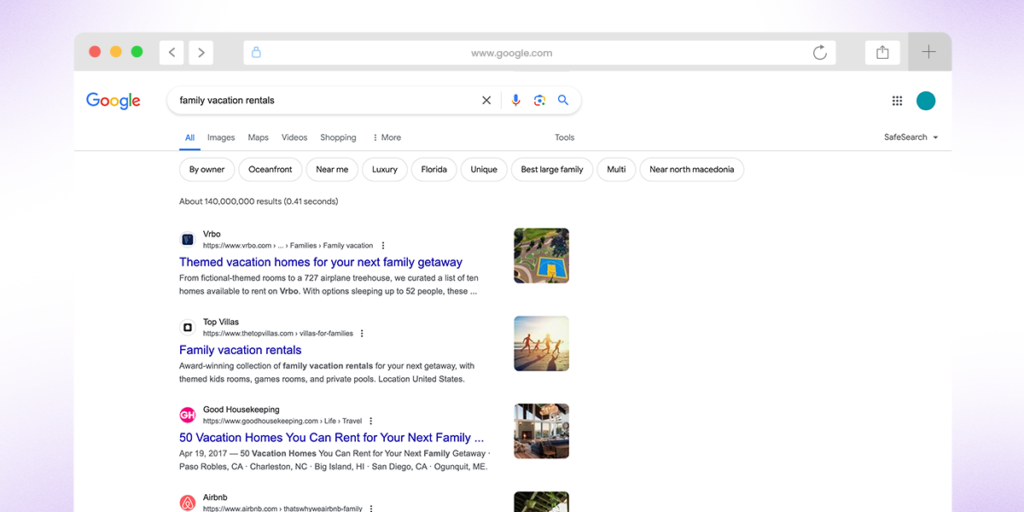
Conduct customer validation interviews
Running customer validation interviews with your target customer groups is a great way to learn about your products potential. Although you should run customer interviews throughout the lifetime of your product, the types of questions that you ask should vary based on the stage of your product.
In the idea validation stage, your goal is to work out what your target markets current behavior actually is. To determine this, you need to first work out who to interview. For instance, in the case of Vrbo, they may have interviewed customers such as families looking for vacation rentals and hosts with larger properties who list on competitive sites.
The goal should be to interview 7 or 8 people and find out how does the target customer currently solve the problem that you’re trying to solve? After you’ve asked a maximum of 8 people, this will tell you what the current market landscape looks like and what is the current behavior of your users.
The goal is to now sit down and brainstorm how you can build a vacation rental marketplace that is slightly better than the nearest competitive alternative, for your target market.
Read how to validate your idea your marketplace idea for more information on this step.
Step 3. Build a minimum viable product
Once you’ve validated that there is market demand for your vacation rental site, the next step is to build an online marketplace MVP (minimum viable product).
To build a successful short term vacation rental marketplace MVP, you should take the following steps.
- Plan your MVP features
- Choose your tech stack
- Choose your business model
- Build and launch your MVP
- Onboard your early adopters
- Learn and grow
Plan your MVP features
The number one rule for a successful marketplace MVP is to build and launch your MVP fast. This is because 99% of people building a rental marketplace fail to ever go live.
As such, you should focus on building a feature set that you can actually deliver within 2 – 3 weeks. Once your rental marketplace is live, you can then adjust your marketplace based on real customer feedback. This will ensure that you’re building features that are focused on your customers actual needs.
Whilst it is essential to launch fast, vacation rental markepalces like Vrbo require a lot of complex, must have features. This include features such as landing pages, location based search, payments, two-sided reviews and so on. All of these features are important from the getgo, since there are already competitive alternatives in the short term vacation rental space.
However, since there are so many required features, this makes it impossible to build a solution like Vrbo quickly using traditional coding methods. For this reason, many people choose to use a specialist rental marketplace technology to build their marketplace MVP. These solutions come with a base set of features that cover the core functionality for a rental marketplace software. You can then focus on designing one or two features that will make your vacation rental site slightly better for your niche, when compared to the nearest competitive alternative.
Once you have decided on these features, you should write them down so that you can keep focus on these features.
Now it is time to choose the technology that you will use to build your vacation rental site.
Choose your tech stack
A vacation rental site like Vrbo is a two-sided, peer-to-peer marketplace.
These are complex platforms and cannot be developed with traditional content management systems such as Wordpress, Webflow or even Shopify. Instead, you have two options. You can either code the marketplace from scratch OR use specialist rental marketplace technology.
The challenge with most marketplace technologies is that, whilst they work well for basic prototyping, these platforms do not scale well. This means that as your usage levels increase, your vacation rental marketplace will become slow and unresponsive, furthermore, you will need to pay substantially higher fees to run your marketplace. Lastly, these solutions do not play well with search engines, meaning that you listing pages will not rank in the Google SERPs (Search Engine Response Pages).
Traditional code meanwhile gives you the option to build a sustainable vacation rental marketplace software. The challenge here is that it will be significantly more expensive and time consuming to develop the marketplace from scratch. For instance, the typical price will be anywhere from $50,000 – $250,000 depending on the quality of team you choose and what features you ask for. Furthermore, even when the marketplace MVP is delivered, you will need to retain these resources in order to keep maintaining and updating the code will is expensive and time consuming.
The last option, is to use a solution like Dittofi’s hybrid no code platform. Dittofi offers a suite of carefully designed, feature rich marketplace templates. Each template is built on modern, high performing technology stack. You can take these templates and install them into Dittofi’s no code marketplace place builder where you can customize the solution in an entirely visual way. Dittofi then converts your visual designs into simple, secure and scalable code that you can either deploy in one click or hand off to developers.
Hybrid no code solutions give you the best of both worlds, combining code with no-code, visual development studios so that you can own an entirely unique, enterprise grade rental marketplace at an affordable rate. These solutions also lower your dependency on expensive and hard to find software developers since, you are able to make adjustments to your software using drag and drop.
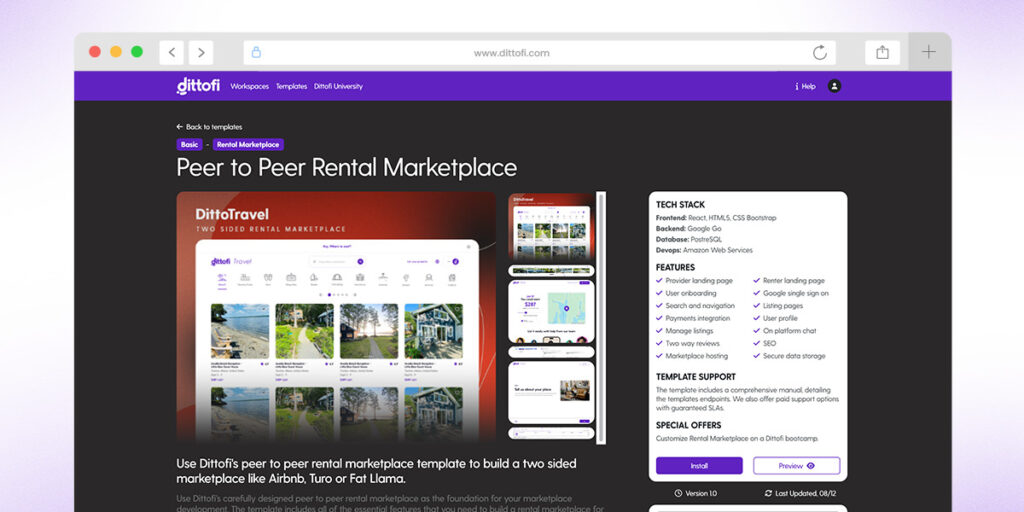
Read how to choose the best a vacation rental marketplace technology to learn more.
Choose a business model
A unique business model can give your marketplace a competitive advantage.
As such, each vacation rental websites like Vrbo, Airbnb, Booking.com and so on, has its own innovative marketplace business model and pricing structure.
For example, in the case of Vrbo, they offer two pricing models an annual subscription fee of $499 for hosts to list their properties or a pay-per-booking model. In the pay-per-bookng model Vrbo charges hosts a 5% commission (or take rate) per booking plus a 3% payment processing fee. This can give hosts with multiple properties an incentive to sign up for 12 months.
Furthermore, and similar to other vacation rental platforms, Vrbo has moved towards a host-only commission model. Whilst previously hosts paid a booking fee and guests paid a service fee e.g. for cleaning the property, now the property owner pays for everything. Whilst this may seem like a worse deal for the hosts, data shows that even though hosts need to increase their rental fee booking conversion is higher since the guests prefer the simplified booking process and lack of hidden fees when compared to platforms like Airbnb.
This is an example of how you can tweak your marketplace business model in order to create a competitive advantage against your competitors.
For the initial version (Version 1) of your vacation rental marketplace, we strongly advise a commission-only business model. This approach eliminates barriers to user sign-ups.
Build and launch your MVP
Whilst short term vacation rental websites require a lot of complex features, nowadays building a website like Vrbo can be done in 2 – 3 weeks. This is because you can leverage specilist marketplace technology and no code marketplace builders, to create feature rich, vacation rental marketplace sites fast.
For instance, below is an an example of how to build and launch a website like Vrbo using Dittofi’s rental marketplace technology.
As we’ve already seen, the benefit to using a hybrid no-code platform like Dittofi is that it combines the best of traditional code and visual development tools, giving you an enterprise grade code base for your marketplace in a matter of seconds. You can then cusotmize your rental marketplace using Dittofi’s visual editor to update the underlying code, ramp up your development and scale up usage or, if you would rather, you can also access and edit the underlying code for your marketplace directly.
To build and launch your vacation rental website, sign up to Dittofi now and create your vacation rental marketplace.
Step 5. Onboard your early adopters
Getting your first users to list their properties on your website can be difficult. This is because, without guests, there is little incentive to for hosts to sign up to the platform. However, without hosts, guest have nowhere to book. This is known as the marketplace chicken and egg problem.
There are several strategies that marketplaces can use to solve the chicken and egg problem. A selection of these are listed below.
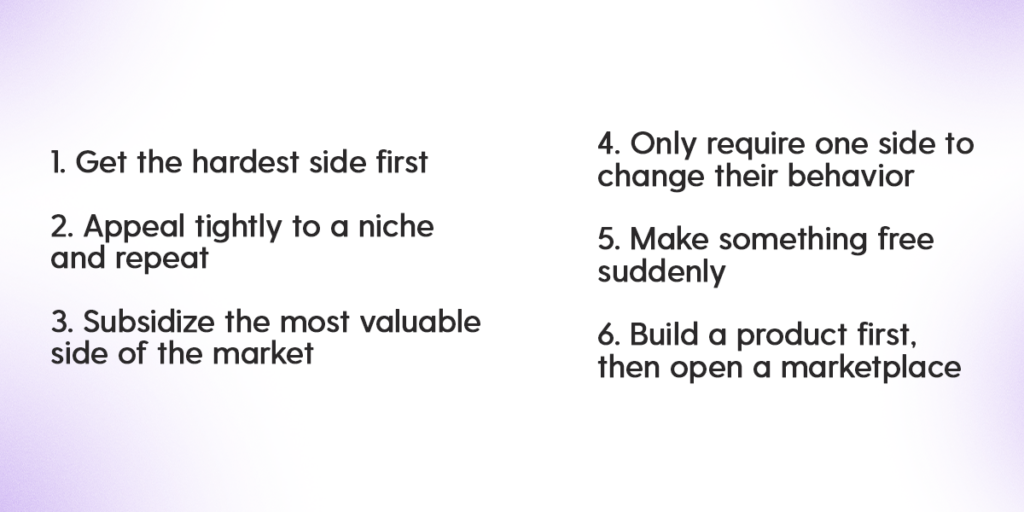
Each of these strategies depends on what kind of marketplace you’re building and what resources you have. As a general rule, you should focus on getting early adopters for one side of your marketplace at a time. Start with the hardest side and then, once you have enough properties or inquires from customers, the next step is get the other side engaged.
In the case of Vrbo, the first property to list was a condo on the Breckendridge Ski Resort in Colorado. This condo belonged to Vrbo’s founder David Clouse. This approach of listing your own property is common for early stage rental marketplaces for example, the founders of Airbnb did the same thing in 2005.
There are several benefits of listing your own property on your rental marketplace MVP. These benefits include, helping solve the marketplace chicken and egg problem and to test and gain valuable insights into how your rental marketplace solution works for hosts.
Using Dittofi’s visual development studio and marketplace templates, there are several ways that you can emulate the approach taken by Vrbo. For instance, you can sign up to your own platform using our templated host onboarding forms. These will allow you to experience what it is like to be a host on the marketplace.
Step 6. Learn and grow
Building a website like Vrbo is an ongoing process.
We’ve already seen how business models can be used to create a competitive advantage however, there are also other areas where you can look to provide a superior experience for hosts and guests.
Below are some example areas where Vrbo looks to provide a superior experience for hosts and guests. These features are developed by focusing on the needs of both sides of their peer to peer marketplace, developing new features and testing the impact that these features have on their marketplace business metrics.
Vrbo’s features for hosts:
- Pricing: Vrbo offers an annual subscription model that is great for hosts who have multiple properties and more frequent bookings. Vrbo also offers hosts the chance to pay a lower transaction fee on rented properties vs the nearest competitive altnerative.
- Cancellation policies: Data suggests that cancelation policies have become an important factor in rental booking decisions. Data suggests that guests tend to choose listings with more flexible cancellation policies. Vrbo offer hosts the chance to set their own custom cancellation policies or to select a standard policies offered by Vrbo.
Vrbo’s features for guests:
- Accomodation type: As we’ve discussed throughout this article, Vrbo’s website targets more high end and spacious accommodation compared to the nearest competitive alternatives.
- Search functionality: Vrbo offers a superior filter and search functionality. For example, Vrbo allows users to filter by user reviews, including properties rated highly for cleanliness, four star and above and so on.
- Transaction flow: The price displayed on a Vbro listing is the price you pay. This is more transparent compared to alternatives which tack on cleaning fees, platform service fees and so on after a guest selects the listing. Although this makes the prices appear higher on websites like Vrbo, it has been proven to also help promote more transactions to take place.
Other areas vacation rental marketplaces can compete include (but are in no way limited to) safety, long stay discounts, customer reviews, insurance policies, accommodation types, renting demographic and so on.
Through a process of continually iterating on your marketplace platform, you will be able to find a feature set that sets you apart from other vacation rental marketplaces.
How much does it cost to build a website like Vrbo?
The cost of building a website like Vrbo will differ depending on several factors such as the level of experience of your development team, if you choose to build your website from scratch or if you choose to use a marketplace hybrid no-code technology like Dittofi.
Based on our experience, we have found that developing a custom website like Vrbo requires an investment of between $50,000 – $250,000. A breakdown of the steps involved and the costs associated with each step are shown below.
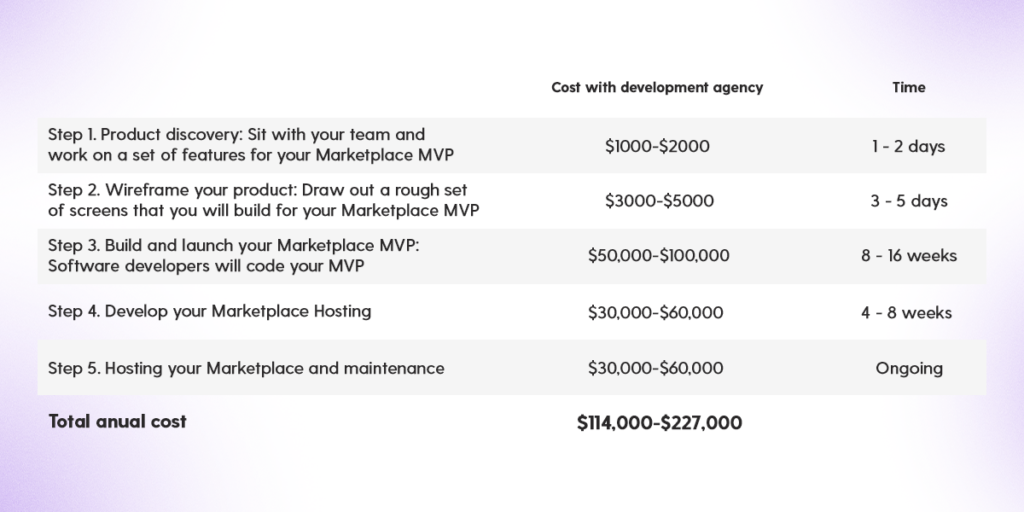
Whilst custom code allows you to build a powerful and unique experience for your customers, the cost is very expensive and unattainable for most companies just looking to test the water.
By contrast, you could use a specialist vacation rental marketplace software. These tend to cost around $3600 per year. These platforms however lack flexibiliy, are very expensive to scale and are only really appropriate for MVP and prototype development. You certainly will not be accomplish the “Learn and grow” stage of development using these tools.
As such, Dittofi offers a hybrid solution that gives you the power of custom code, but in a low cost and scalable way. Using Dittofi you can develop an enterprise grade vacation rental website like Vrbo, on a modern tech stack that can be customized with the same flexibility as coding. The cost of building a vactaion rental website like Vrbo with Dittofi is shown below.
Choosing a hybrid no-code platform can provide flexibility, lower costs, and faster deployment compared to traditional coding methods.
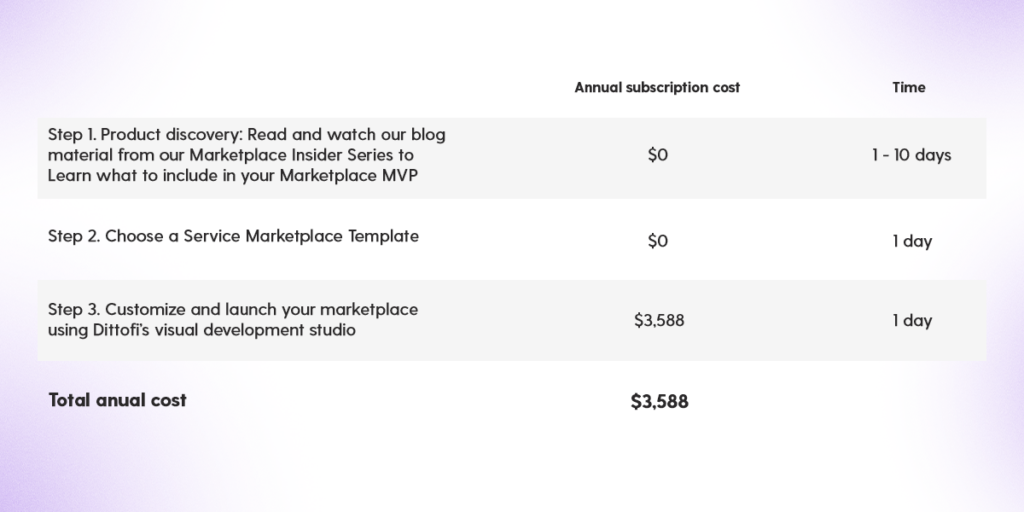
In addition to the cost involved in building your website, you should also consider the marketing cost that you would expect to experience in year 1. This is shown below for a basic marketing strategy that combines paid and unpaid channels.
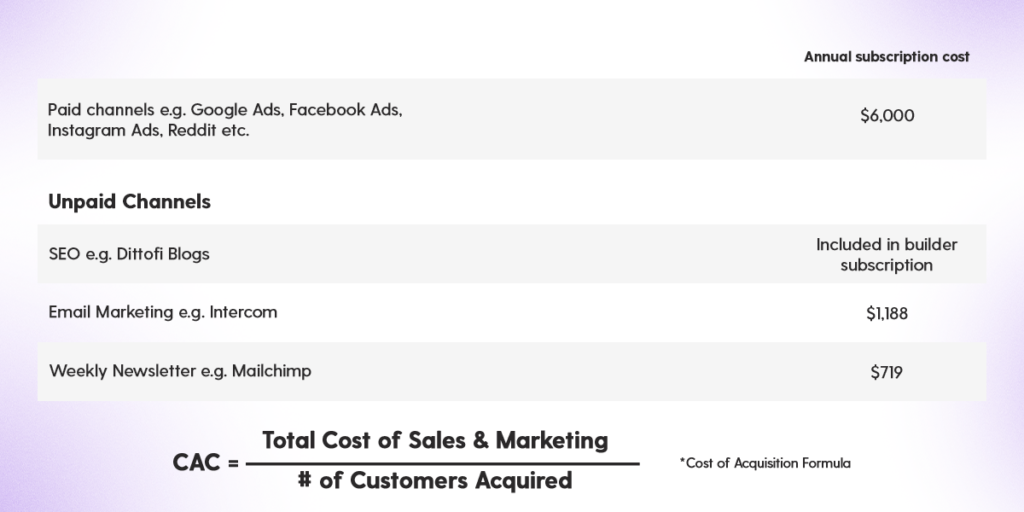
Conclusion: How do I create a website like Vrbo
Building a website like Vrbo is not easy, but it’s definitely achievable with the right tools and strategies.
Don’t let this hold you back!
There is a huge market for vacation rentals and there are many opportunities to build a niche website like Vrbo that can grow to take a significant slice of the action.
Nowadays, platforms like Dittofi have removed the technical barrier to entry giving you the opportunity to create an outstanding vacation rental marketplace platform like Vrbo, Airbnb, Booking.com or many more.
If you would like to speak to anyone about setting up your marketplace book a call with our marketplace specialists.
Otherwise, you can sign up to Dittofi for a free trial and build your marketplace today.
And… as always… if we don’t hear from you, we wish you the best of luck with all of your vacation rental marketplace development 🙂
Become a Marketplace Insider
Join our inner circle for exclusive insights, coveted trade secrets, and unparalleled strategies – your journey to marketplace dominance begins here.

